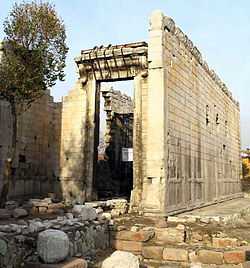Monumentum Ancyranum

The name Monumentum Ancyranum refers to the Temple of Augustus and Rome in Ancyra (modern Ankara, Turkey), or to the inscription Res Gestae Divi Augusti, a text recounting the deeds of the first Roman emperor Augustus, the most intact copy of which is preserved on the walls of this temple.
Construction
The temple was built between 25 BC - 20 BC after the conquest of central Anatolia by the Roman Empire and the formation of the Galatia province, with Ancyra as its administrative capital.
The Res Gestae Divi Augusti
After the death of Augustus in 14 AD, a copy of the text of the Res Gestae Divi Augusti was inscribed on both walls inside the pronaos in Latin, with a Greek translation on an exterior wall of the cella.
The inscriptions are the primary surviving source of the text, since the original inscription on bronze pillars in front of the Mausoleum of Augustus in Rome has long been lost, and two other surviving inscriptions of the text are incomplete.[1]
The Monumentum Ancyranum was first made known to the western world by Ogier Ghiselin de Busbecq,[2] ambassador of Ferdinand of Austria, to the Sultan Suleyman the Magnificent (1555–1562) at Amasia in Asia Minor. Busbecq first read the inscription and identified its origin from his reading of Suetonius; he published a copy of parts of it in his Turkish Letters.[3]
See also
- Temple of Divus Augustus
- Temple of Augustus (Pula)
- Temple of Augustus in Barcelona
- Res Gestae Divi Augusti
- Augustus
- Galatia
- Ankara
References
- Botteri P. and Fangi G. (2003). The Ancyra Project: the Temple of Augustus and Rome in Ankara, ISPRS Archives, volume XXXIV part 5/W12 Commission V, pp 84–88.
Notes
- ↑ Diehl, editor of Res Gestae Divi Augusti in the Loeb Classical Library remarks that at the time the original document was copied on the walls of many of the temples of Augustus throughout the empire, but the inscriptions have not survived.
- ↑ Diehl, in the Loeb Classical Library, gives his name as Buysbecche; Busbecq was also instrumental in introducing the lilac to European gardens, and probably tulip, through the bulbs he sent to Carolus Clusius.
- ↑ Edward Seymour Forster, translator, The Turkish Letters of Ogier de Busbecq reprinted Louisiana State University 2005.
External links
Coordinates: 39°56′40″N 32°51′30″E / 39.94444°N 32.85833°E